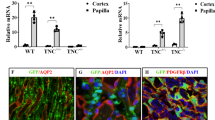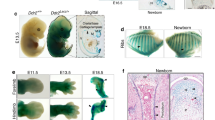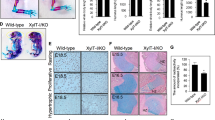Abstract
Basement membrane (BM) morphogenesis is critical for normal kidney function1. Heterotrimeric type IV collagen, composed of different combinations of six α-chains (1–6), is a major matrix component of all BMs (ref. 2). Unlike in other BMs, glomerular BM (GBM) contains primarily the α3(IV) and α4(IV) chains, together with the α5(IV) chain3,4. A poorly understood, coordinated temporal and spatial switch in gene expression from ubiquitously expressed α1(IV) and α2(IV) collagen to the α3(IV), α4(IV) and α5(IV) chains occurs during normal embryogenesis of GBM (ref. 4). Structural abnormalities of type IV collagen have been associated with diverse biological processes including defects in molecular filtration in Alport syndrome5,6, cell differentiation in hereditary leiomyomatosis7, and autoimmunity in Goodpasture syndrome7; however, the transcriptional and developmental regulation of type IV collagen expression is unknown. Nail patella syndrome (NPS) is caused by mutations in LMX1B, encoding a LIM homeodomain transcription factor. Some patients have nephrosis-associated renal disease characterized by typical ultrastructural abnormalities of GBM (refs. 8,9). In Lmx1b−/− mice, expression of both α(3)IV and α(4)IV collagen is strongly diminished in GBM, whereas that of α1, α2 and α5(IV) collagen is unchanged. Moreover, LMX1B binds specifically to a putative enhancer sequence in intron 1 of both mouse and human COL4A4 and upregulates reporter constructs containing this enhancer-like sequence. These data indicate that LMX1B directly regulates the coordinated expression of α3(IV) and α4(IV) collagen required for normal GBM morphogenesis and that its dysregulation in GBM contributes to the renal pathology and nephrosis in NPS.
This is a preview of subscription content, access via your institution
Access options
Subscribe to this journal
Receive 12 print issues and online access
$209.00 per year
only $17.42 per issue
Buy this article
- Purchase on Springer Link
- Instant access to full article PDF
Prices may be subject to local taxes which are calculated during checkout




Similar content being viewed by others
References
Desjardins, M. & Bendayan, M. Ontogenesis of glomerular basement membrane: structural and functional properties. J. Cell Biol. 113, 689–700 (1991).
Sado, Y. et al. Organization and expression of basement membrane collagen IV genes and their roles in human disorders. J. Biochem. (Tokyo) 123, 767–776 (1998).
Harvey, S.J. et al. Role of distinct type IV collagen networks in glomerular development and function. Kidney Int. 54, 1857–1866 (1998).
Miner, J.H. & Sanes, J.R. Collagen IV α3, α4, and α5 chains in rodent basal laminae: sequence, distribution, association with laminins, and developmental switches. J. Cell Biol. 127, 879–891 (1994).
Barker, D.F. et al. Identification of mutations in the COL4A5 collagen gene in Alport syndrome. Science 248, 1224–1227 (1990).
Mochizuki, T. et al. Identification of mutations in the α3(IV) and α4(IV) collagen genes in autosomal recessive Alport syndrome. Nature Genet. 8, 77–81 (1994).
Hudson, B.G., Reeders, S.T. & Tryggvason, K. Type IV collagen: structure, gene organization, and role in human diseases. Molecular basis of Goodpasture and Alport syndromes and diffuse leiomyomatosis. J. Biol. Chem. 268, 26033–26036 (1993).
Dreyer, S.D. et al. Mutations in LMX1B cause abnormal skeletal patterning and renal dysplasia in nail patella syndrome. Nature Genet. 19, 47–50 (1998).
Taguchi, T., Takebayashi, S., Nishimura, M. & Tsuru, N. Nephropathy of nail-patella syndrome. Ultrastruct. Pathol. 12, 175–183 (1988).
Vainio, S. & Muller, U. Inductive tissue interactions, cell signaling, and the control of kidney organogenesis. Cell 90, 975–978 (1997).
Heikkila, P., Soininen, R. & Tryggvason, K. Directional regulatory activity of cis-acting elements in the bidirectional α1(IV) and α2(IV) collagen gene promoter. J. Biol. Chem. 268, 24677–24682 (1993).
Momota, R. et al. Two genes, COL4A3 and COL4A4 coding for the human α3(IV) and α4(IV) collagen chains are arranged head-to-head on chromosome 2q36. FEBS Lett. 424, 11–16 (1998).
Ninomiya, Y. et al. Differential expression of two basement membrane collagen genes, COL4A6 and COL4A5, demonstrated by immunofluorescence staining using peptide- specific monoclonal antibodies. J. Cell Biol. 130, 1219–1229 (1995).
Sutcliffe, N.P., Cashman, S.J., Savage, C.O., Fox, J.G. & Boulton-Jones, J.M. Variability of the antigenicity of the glomerular basement membrane in nail-patella syndrome. Nephrol. Dial. Transplant. 4, 262–265 (1989).
Chen, H. et al. Limb and kidney defects in Lmx1b mutant mice suggest an involvement of Lmx1b in human nail patella syndrome. Nature Genet. 19, 51–55 (1998).
Riddle, R.D. et al. Induction of the LIM homeobox gene Lmx1 by WNT7a establishes dorsoventral pattern in the vertebrate limb. Cell 83, 631–640 (1995).
Leimeister, C., Bach, A. & Gessler, M. Developmental expression patterns of mouse sFRP genes encoding members of the secreted frizzled related protein family. Mech. Dev. 75, 29–42 (1998).
Ruotsalainen, V. et al. Nephrin is specifically located at the slit diaphragm of glomerular podocytes. Proc. Natl. Acad. Sci. USA 96, 7962–7967 (1999).
Miner, J.H. & Sanes, J.R. Molecular and functional defects in kidneys of mice lacking collagen α3(IV): implications for Alport syndrome. J. Cell Biol. 135, 1403–1413 (1996).
Kalluri, R. & Cosgrove, D. Assembly of type IV collagen. Insights from α3(IV) collagen-deficient mice. J. Biol. Chem. 275, 12719–12724 (2000).
German, M.S., Wang, J., Chadwick, R.B. & Rutter, W.J. Synergistic activation of the insulin gene by a LIM-homeo domain protein and a basic helix-loop-helix protein: building a functional insulin minienhancer complex. Genes Dev. 6, 2165–2176 (1992).
Lefebvre, V. et al. An 18-base-pair sequence in the mouse pro-α-1(II) collagen gene is sufficient for expression in cartilage and binds nuclear proteins that are selectively expressed in chondrocytes. Mol. Cell. Biol. 16, 4512–4523 (1996).
Haerry, T.E. & Gehring, W.J. A conserved cluster of homeodomain binding sites in the mouse Hoxa-4 intron functions in Drosophila embryos as an enhancer that is directly regulated by Ultrabithorax. Dev. Biol. 186, 1–15 (1997).
Dorsett, D. Distant liaisons: long-range enhancer-promoter interactions in Drosophila. Curr. Opin. Genet. Dev. 9, 505–514 (1999).
Lu, W. et al. Insertional mutation of the collagen genes Col4a3 and Col4a4 in a mouse model of Alport syndrome. Genomics 61, 113–124 (1999).
Noakes, P.G. et al. The renal glomerulus of mice lacking s-laminin/laminin β2: nephrosis despite molecular compensation by laminin β1. Nature Genet. 10, 400–406 (1995).
McIntosh, I. et al. Mutation analysis of LMX1B gene in nail-patella syndrome patients. Am. J. Hum. Genet. 63, 1651–1658 (1998).
Albrecht, U. et al. Studying gene expression on tissue sections using in situ hybridization. in Human Genome Methods (ed. Adolph, K.W.) 93–119 (CRC Press, Boca Raton, 1998).
Sado, Y. et al. Establishment by the rat lymph node method of epitope-defined monoclonal antibodies recognizing the six different α chains of human type IV collagen. Histochem. Cell Biol. 104, 267–275 (1995).
Dreyer, S.D. et al. LMX1B transactivation and expression in nail-patella syndrome. Hum. Mol. Genet. 9, 1067–1074 (2000).
Acknowledgements
We thank R.L. Johnson for Lmx1b−/− mice and O. Hernandez for editorial assistance. This work was supported by the Deutsche Forschungsgemeinschaft (S.D.D., B.Z.), the National Institutes of Health grants AR44738 (B.L.), DK53763 (P.S.T.), DK53196 (J.H.M.), and HD01204 (K.C.O.), March of Dimes Birth Defects Foundation (B.L.), the Arthritis Foundation (B.L., G.Z.), the Baylor College of Medicine Child Health Research Center (B.L.) and the Baylor College of Medicine Mental Retardation Research Center (B.L.).
Author information
Authors and Affiliations
Corresponding author
Rights and permissions
About this article
Cite this article
Morello, R., Zhou, G., Dreyer, S. et al. Regulation of glomerular basement membrane collagen expression by LMX1B contributes to renal disease in nail patella syndrome. Nat Genet 27, 205–208 (2001). https://doi.org/10.1038/84853
Received:
Accepted:
Issue Date:
DOI: https://doi.org/10.1038/84853
This article is cited by
-
Expert consensus guidelines for the genetic diagnosis of Alport syndrome
Pediatric Nephrology (2019)
-
Steroid-resistant nephrotic syndrome as the initial presentation of nail-patella syndrome: a case of a de novo LMX1B mutation
BMC Nephrology (2017)
-
Spectrum of LMX1B mutations: from nail–patella syndrome to isolated nephropathy
Pediatric Nephrology (2017)
-
Nail-patella syndrome
Pflügers Archiv - European Journal of Physiology (2017)
-
Hair and Nail Manifestations of Systemic Disease
Current Dermatology Reports (2017)



